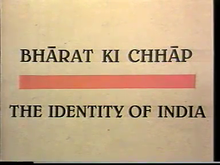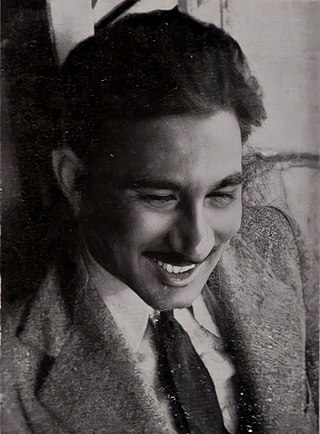
Khwaja Ahmad Abbas was an Indian film director, screenwriter, novelist, and journalist in Urdu, Hindi and English.

Kishore Kumar was an Indian playback singer, musician and actor. He is widely regarded as one of the greatest, most influential and dynamic singers in the history of modern Indian music. Kumar was one of the most popular singers in the Indian subcontinent, notable for his yodelling and ability to sing songs in different voices. He used to sing in different genres but some of his rare compositions, considered classics, were lost in time.
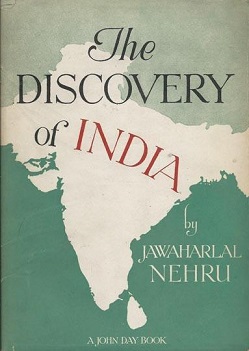
The Discovery of India was written by the Indian freedom fighter Jawaharlal Nehru during his incarceration in 1942–1945 at Ahmednagar Fort in present-day Indian state of Maharashtra by British colonial authorities before the independence of India. The book was written in 1944 but published in 1946.

Bharat Ek Khoj is a 53-episode Indian historical drama based on the book The Discovery of India (1946) by Jawaharlal Nehru that covers a 5,000-year history of the Indian subcontinent from its beginnings to independence from the British in 1947. The drama was directed, written and produced by Shyam Benegal with cinematographer V. K. Murthy in 1988 for state-owned Doordarshan. Shama Zaidi co-wrote the script. Its cast included Om Puri, Roshan Seth, Tom Alter and Sadashiv Amrapurkar. Jawaharlal Nehru was portrayed by Roshan Seth, the same role he portrayed in the film Gandhi.

Basu Chatterjee was an Indian film director and screenwriter in Hindi Cinema.Through the 1970s and 1980s, he became associated with what came to be known as middle cinema or middle-of-the-road cinema filmmakers, such as Hrishikesh Mukherjee and Basu Bhattacharya, whom he assisted on Teesri Kasam (1966). Like their films, his films dealt with light-hearted stories of middle-class families often in urban settings, focusing on marital and love relationships.
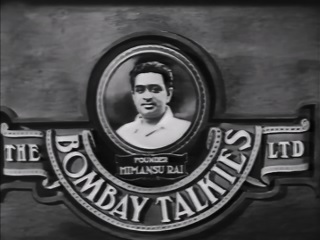
Bombay Talkies was a movie studio founded in 1934. During its period of operation, Bombay Talkies produced 40 movies in Malad, a suburb of the Indian city of Bombay.

Dharampal was an Indian historian, historiographer, and an Gandhian thinker. Dharampal primary works are based on documentation by the colonial government on Indian education, agriculture, technology, and arts during the period of colonial rule in India. He is most known for his works The Beautiful Tree: Indigenous Indian Education in the Eighteenth Century (1983), Indian Science and Technology in the Eighteenth Century (1971) and Civil Disobedience and Indian Tradition (1971), among other seminal works, which have led to a radical reappraisal of conventional views of the cultural, scientific and technological achievements of Indian society at the eve of the establishment of Company rule in India. Dharampal was instrumental in changing the understanding of pre-colonial Indian education system.

Sushmita Mukherjee is an Indian actress and author. She has starred in several Hindi movies and television shows.

Manoj N. Joshi is an Indian actor known for working in film, stage and television. He has also acted in over 70 films since 1998, many of his roles being comic roles. Joshi is the recipient of several awards including a National Film Award. In 2018, Joshi was awarded with the Padma Shri. He is the vice-president of the Bombay Art Society.

Vanraj Bhatia was an Indian composer best known for his work in Indian New Wave cinema. He was also one of the leading composers of Western classical music in India.

Abhi Bhattacharya was an Indian actor of Hindi and Bengali cinema, who is most remembered for his roles in films of the 1950s and the 1960s, such as Yatrik (1952), Jagriti (1954), Anuradha (1960), Subarnarekha (1965) and Amanush 1975. In his four decade long acting career he performed in more than 150 films in Hindi and 21 in Bengali. Abhi Bhattacharya worked with eminent film directors of India such as Ritwik Ghatak, Guru Dutt, Bimal Roy and Satyen Bose.

Indian Institute of Technology Gandhinagar is a public technical university located in Gandhinagar, Gujarat, India. It has been declared to be an Institute of National Importance by the Government of India. Established in 2008, IIT Gandhinagar campus is spread over 400 acres of land along the river Sabarmati.

Dr. Aanjjan Srivastav is an Indian film, television and stage actor, associated with Indian People's Theatre Association (IPTA) in Mumbai of which he remained Vice-President for several years. Outside theatre, he is best known as a character actor in Marathi and Hindi films, most notably, Mira Nair's Salaam Bombay!, Mississippi Masala and Anupam Mittal's Flavors and Bollywood films like Gol Maal, Bemisal, Khuda Gawah, Kabhi Haan Kabhi Naa and Pukar. He has also acted in the TV shows Wagle Ki Duniya (1988) and Wagle Ki Duniya – Nayi Peedhi Naye Kissey (2021).

Mushtaq Khan is an Indian film and television actor and comedian who has worked in several Hindi films in a career spanning three decades. He is best known for his roles in films like Hum Hain Rahi Pyar Ke (1993), Jodi No.1 (2001) and Welcome (2007).

Ramadas Panemangalore Shenoy was an Indian defence scientist and writer, known for his contributions in the field of radar technology. He secured a doctoral degree in electrical engineering from the University of Wisconsin–Madison and joined Defence Research and Development Organization in 1961, involving himself with the indigenous development of radar technology till his retirement, as a Distinguished Scientist, in 1989.
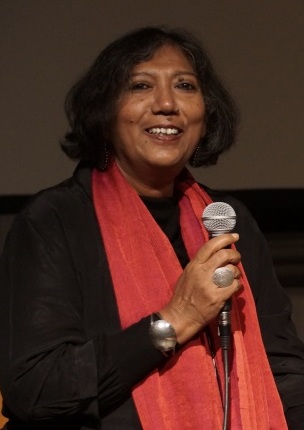
Madhusree Dutta is an Indian filmmaker, author and curator.
Shantaram is an American-Australian drama thriller television series created by Eric Warren Singer and Steve Lightfoot, based on the novel of the same name by Gregory David Roberts. The story drew inspiration from Roberts' own life, which is about a bank robber from Australia who flees the country to India. The series consists of twelve episodes directed by Bharat Nalluri, Iain B. MacDonald and Bronwen Hughes. Steve Lightfoot joined as showrunner after Eric Warren Singer departed the project. It is produced by Fair Honest Positive Creative, The 4 Keys, Bohemian Risk Productions, Square Head Productions, Anonymous Content and Paramount Television Studios and was distributed by Apple Inc. for their streaming service, Apple TV+. The series premiered on 14 October 2022 and concluded on 16 December 2022. In December 2022, the series was cancelled after one season.

CIIE.CO is an Indian startup accelerator and incubator that supports early-stage startups located at IIM Ahmedabad in Ahmedabad, India. It was founded in 2002 to promote innovation and entrepreneurship in India. It is a Center of excellence set up at Indian Institute of Management Ahmedabad with support from the Government of India's Department of Science and Technology and the Government of Gujarat.
Chandita Mukherjee was an Indian documentary filmmaker, science communicator and activist. She was the recipient of two National Film Awards. She conceived and directed the TV series Bharat Ki Chhap on the history of science and technology in India. She was the executive director of Comet Media Foundation.
